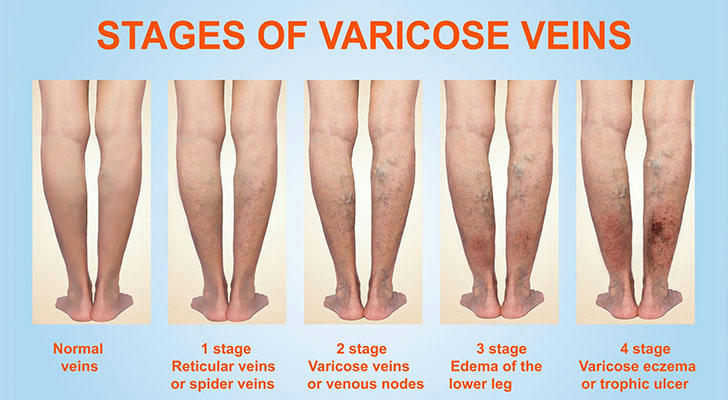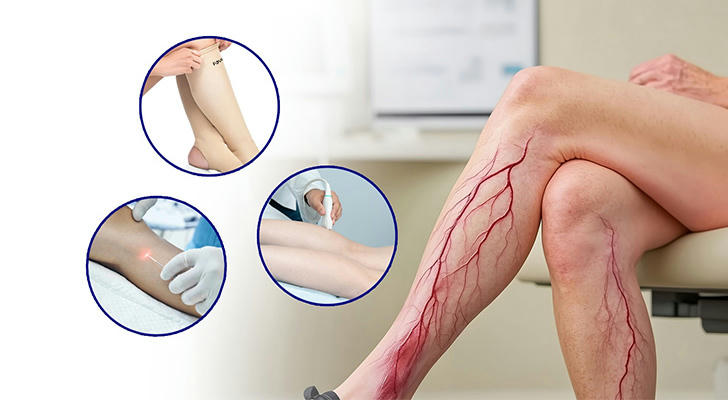🩸 Varicose Veins: Not Just Blue Veins on the Legs, It could threaten your life!
In the United States, more than 30% of adults are experiencing some degree of varicose veins. You may have seen the blue veins coiled on your calves in the mirror, or you may feel heavy and sore legs after standing for a long time. These seemingly ordinary symptoms may actually be early signals from the body — varicose veins.

🔬 What Are Varicose Veins?
Varicose veins refer to the enlargement, deformation, and congestion of superficial veins, usually in the legs. When the valve function inside the veins is damaged and blood cannot flow back to the heart smoothly, it accumulates in the blood vessels, causing venous dilation and vascular bulges.
👣 These 5 Types of People Are Most Likely to Get Varicose Veins
Have you been affected? Standing or sitting for a long time will slow blood circulation in the lower limbs, increase pressure, and induce vein dilation.
1️⃣ Sedentary/Standing Workers
e.g., nurses, teachers, drivers, factory workers, office staff.
2️⃣ High Obesity Rate
Excess weight increases venous pressure in the lower extremities.
3️⃣ Pregnant Women
Hormones and fetal pressure affect venous function.
4️⃣ Aging Population
The older you are, the higher the risk of venous valve degeneration.
5️⃣ Family Inheritance
If your parents have varicose veins, you're more likely to develop them.
🧬 Common Symptoms of Varicose Veins
- Bulging, tangled, and darker blood vessels in the calf
- Heaviness or soreness in the calf, especially in the evening
- Night leg cramps
- Discoloration, itching, or inflammation of the skin
- In severe cases: phlebitis, ulcers, or thrombosis
⚠️ 7 Major Hazards of Varicose Veins
1️⃣ Leg Soreness and Pain
Blood congestion causes heaviness, cramps, and tingling.
2️⃣ Darkening and Hardening of the Skin
Long-term congestion leads to discoloration and rough skin.
3️⃣ Itching and Eczema
Poor blood flow causes irritation and rashes.
4️⃣ Ulcers Difficult to Heal
Wounds near the ankles may rupture, ooze, and recur.
5️⃣ High Risk of Bleeding
Superficial veins may rupture from minor bumps.
6️⃣ Superficial Phlebitis/Thrombosis
Redness, swelling, heat, and pain — may affect walking.
7️⃣ Deep Vein Thrombosis (DVT)
Clots may lead to pulmonary embolism, a life-threatening condition.
✅ Effective Treatments for Varicose Veins
Fortunately, the U.S. has world-leading treatment technology, and most symptomatic cases are covered by insurance.
| Treatment | Description | Covered by Insurance |
|---|---|---|
| Compression Stockings | Non-invasive, improves circulation | ✅ Yes |
| Sclerotherapy | Injection to close small veins | ✅ Most cases |
| Laser Therapy | Cosmetic spider vein treatment | ❌ Not if cosmetic |
| Radiofrequency/Laser Ablation | Minimally invasive for large veins | ✅ Yes |
| Vein Stripping/Phlebectomy | Surgery for severe or recurrent cases | ✅ Yes |
💡 Note: Most private insurance or Medicare will not cover spider vein removal for cosmetic reasons. But if you have pain, swelling, or inflammation, it qualifies as a medical issue and is covered.
🏃 How to Prevent or Delay Varicose Veins?
- Maintain a healthy weight
- Exercise more, especially walking and leg lifting
- Avoid prolonged standing or sitting
- Wear medical-grade compression stockings
- Eat a high-fiber diet, avoid constipation (which raises abdominal pressure)
🔍 When Should You See a Doctor?
Consult a doctor if you have:
- Obvious bulging leg veins
- Frequent cramps or soreness
- Discolored or hardened skin on calves
- History of leg vein thrombosis
📍 Where to Get Treated in the U.S.?
You can contact the following for diagnosis and treatment:
- USA Vein Clinics
- Center for Vein Restoration
- Vascular surgery or dermatology departments at local hospitals
📢 Summary
Varicose veins are not just cosmetic or age-related — they may be an early warning sign of impaired blood flow. In the U.S., modern treatment options are mature, safe, and mostly covered by insurance. The earlier you take action, the better the results.
If you or someone you know has symptoms, don’t ignore it — seek professional help and give your legs the care they deserve!

